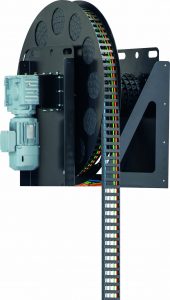Justin Leonard, chain director at igus, outlines some of the options available for managing moving cables in vertical installations.
In the vertical plane, the two most common types of configuration are hanging or standing; the third, which is less conventional, involves a ‘zig-zig’ arrangement. Since these configurations are all very different, it is also important to consider the unique design attributes of each.
Vertical standing
Vertical standing configurations are generally used for short travel lengths – such as those found in simple pick and place applications. Here it is important to consider how the cables are laid in the cable carrier and how they are secured at the end points. You would therefore need to ensure that, during installation, they can bend freely and are strain relieved at both ends. Locking mounting brackets are highly recommended for their aesthetic plush finish appeal and should be mounted in such as a way so that the cable carrier does not bow outwards. If lateral acceleration occurs, support along the outer radius is recommended, and for taller standing applications, it is generally recommended that a minimum of the first three links on the outer radius is supported. For extreme heights and fill weights, it is advisable that the entire length of the energy chain is supported.
 Vertical hanging
Vertical hanging
For long travel lengths, such as those found in storage and retrieval applications, a vertical hanging configuration is recommended. As with vertical standing, the two most important factors to consider are how the cables are laid in the cable carrier and how they are secured at the end points, and bear in mind the overall weight of the system. If the application involves vertical motion without lateral acceleration, the energy chain can be installed without lateral support. However, if there is lateral acceleration – and it can be in one or two directions – lateral guidance is advised. As a rule, guidance is recommended at any point where the energy chain might sway.
For hanging applications with an exceptionally small installation space, drum and reel solutions are often used. One of the down sides of this system, however, is that generally only one cable type can be used. A complete system, e-spool eliminates this issue by allowing many different cable types to be managed together, accommodating diameters up to 17mm in any direction. It can be driven by hand or, for high up applications such as lighting beams and indoor cranes, fitted with an electric motor.
Zig-zag
For applications with strict space constraints, a less conventional configuration known as ‘zig-zag’ can be used. This type of installation is very common for lifts and stages within event venues, where a variety of cables (eg power, AV etc) need to be housed and protected. It is important, once again, to ensure good cable separation and strain relief in this orientation because of the various moving joints.






